technical data SKODA FABIA 2003 1.G / 6Y User Guide
[x] Cancel search | Manufacturer: SKODA, Model Year: 2003, Model line: FABIA, Model: SKODA FABIA 2003 1.G / 6YPages: 233, PDF Size: 32.04 MB
Page 26 of 233

Instruments and Indicator/Warning Lights25
Using the systemSafetyDriving TipsGeneral MaintenanceBreakdown assist-
anceTechnical DataFabia Praktik
– Investigate the function indicated.
– Obtain professional assistance.
Meaning of the red symbols:
Three successive warning signals will sound if a red symbol appears.
If several operational faults of priority 1 exist, the symbols appear one after
the other and are each illiminated for about 2 seconds.
Yellow symbols
A yellow symbol signals a warning.
The meaning of the yellow symbols:
Faults in the brake system⇒ page 35
Coolant level too low/coolant tempera-
ture too high⇒page 31
Engine oil pressure too low⇒page 32
Fuel level low⇒page 31
Check engine oil level, engine oil sensor
faulty⇒page 32
Brake pad worn⇒page 32
Washer fluid level low⇒page 33
Light bulb defect⇒page 33
Light bulb in the brake light defect⇒page 33
Fig. 15 Information
display: Brake pad
worn
Page 28 of 233
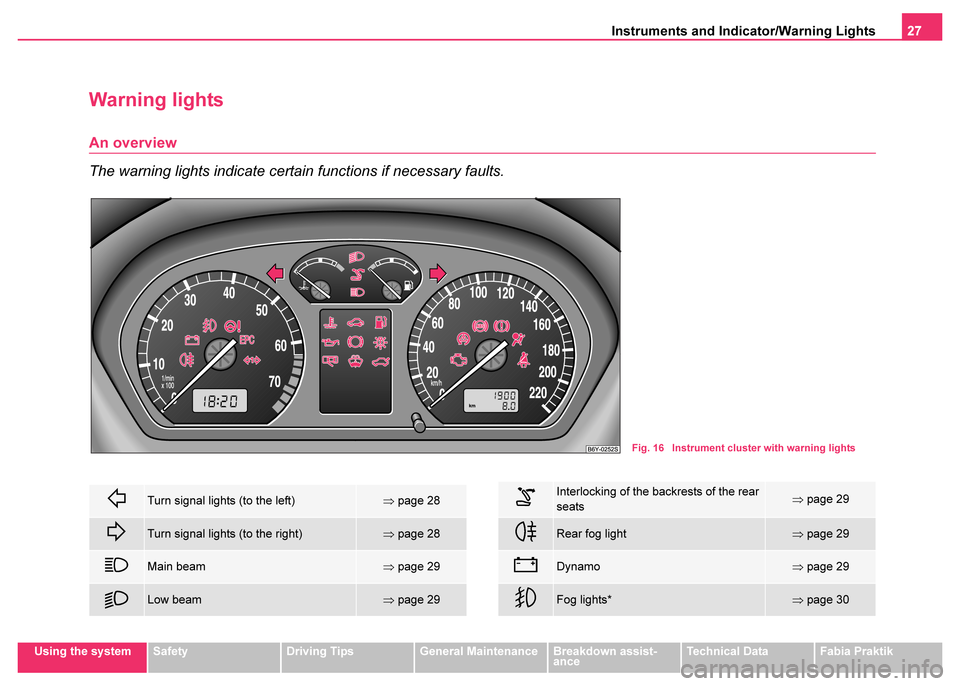
Instruments and Indicator/Warning Lights27
Using the systemSafetyDriving TipsGeneral MaintenanceBreakdown assist-
anceTechnical DataFabia Praktik
Warning lights
An overview
The warning lights indicate certain functions if necessary faults.
Fig. 16 Instrument cluster with warning lights
Turn signal lights (to the left)⇒page 28
\bTurn signal lights (to the right)⇒page 28
Main beam⇒page 29
Low beam⇒page 29
Interlocking of the backrests of the rear
seats⇒page 29
Rear fog light⇒page 29
\fDynamo⇒page 29
Fog lights*⇒page 30
Page 30 of 233

Instruments and Indicator/Warning Lights29
Using the systemSafetyDriving TipsGeneral MaintenanceBreakdown assist-
anceTechnical DataFabia Praktik
Main beam
The indicator light comes on when the main beam is selected or also
when the headlight flasher is operated.
Further information about the main beam ⇒page 54.
Low beam
The indicator light comes on when low beam is selected ⇒ page 52.
Interlocking of the backrests of the rear seats*
The warning light is only installed on vehicles with a three-point safety
belt on the middle rear seat.
The warning light lights up for 20 seconds after the ignition is switched on
if the backrests of the rear seats are not interlocked.
The warning light will light up permanently if the backrest comes loose
while driving.
The rear fog light
The warning light comes on when the rear fog lights are operating
⇒ page 53.
Dynamo
The warning light comes on after the ignition has been switched on. It
should go out after the engine has started.
If the warning light does not go off after the engine is started or comes on
when driving, stop the car and switch the engine off . Check the V-
ribbed belt.
One can still drive to the next Skoda dealer if the V-ribbed belt is in good
order but the warning light is still lit up. The vehicle battery will be
discharged in this case so switch off all non-essential electrical compo-
nents.
The following text will be displayed in the information display*:
ALTERNATOR WORKSHOP!
Caution
If the warning light comes on when driving and the warning light
(cooling system fault) also comes on in display then you must stop the
vehicle immediately and switch the engine off. The coolant pump is no
longer being driven - risk of damage to engine! WARNING
The three-point safety belt can only fulfil its function reliably when
the backrests of the rear seats are correctly locked into position
⇒ page 67.
Page 32 of 233

Instruments and Indicator/Warning Lights31
Using the systemSafetyDriving TipsGeneral MaintenanceBreakdown assist-
anceTechnical DataFabia Praktik
Coolant temperature/coolant level
The warning light comes on for a few seconds 1) when the ignition is
switched on.
The coolant temperature is too high or the coolant level too low if the
warning light
does not go out after the engine is started or flashes while
driving.
3 peeps sound as an additional warning signal.
In this case stop and switch the engine off and check the coolant level;
top up the coolant as necessary.
Do not continue your journey if for some reason it is not possible under
the conditions prevailing to top up with coolant. Switch off the engine
and obtain professional assistance from a Škoda dealer.
If the coolant is within the specified range, the increased temperature may
be caused by an operating problem at the radiator fan. Check the fuse of
the fan and insert a new fuse, if necessary ⇒page 210.
Do not continue driving if the warning light does not go off although the
fluid is at the correct level and also the fuse of the fan is in proper order.
Contact a Škoda dealer to obtain assistance.
Please also refer to the additional instructions ⇒page 177, “Cooling
system”.
The following text will be displayed in the information display*:
STOP CHECK COOLANT SERVICE MANUAL
Electronic immobiliser
Data is compared between the ignition key and the control unit when
switching on the ignition. The indicator light will light up for a few
seconds when ignition key authorisation is confirmed.
The warning light will start flashing continuously if a non-authorised igni-
tion key (for example the wrong ignition key) has been used. The engine
cannot be started ⇒page 39.
It is only possible to start the engine of the vehicle with a Genuine Škoda
key with the matching code.
Fuel reserve \f
The warning light \f comes on, if the fuel level is still about 7 litres.
A peep sounds as an additional warning signal.
The following text will be displayed in the information display*:
PLEASE REFUEL
1)The warning light on vehicles fitted with information display does not come on
after switching the ignition on, but only if a fault exists or the coolant level is too
low.
WARNING
•Take care when opening the coolant expansion bottle. If the
engine is hot, the cooling system is pressurized - risk of scalding.
It is best to allow the engine to cool down before removing the cap.
•Do not touch the coolant fan The coolant fan may switch on
automatically even if the ignition is off.
Page 34 of 233
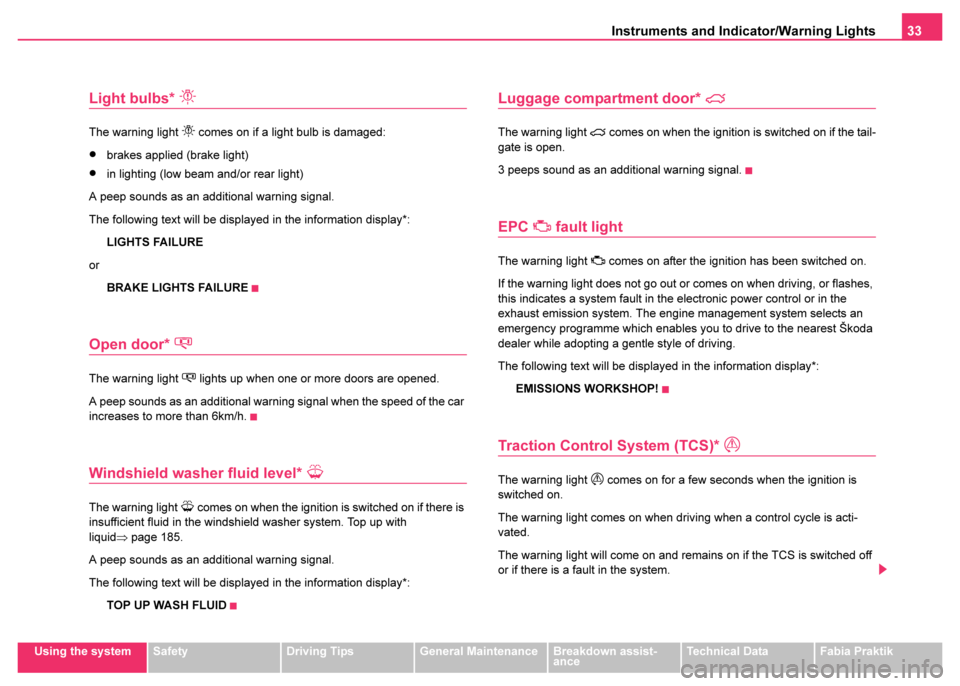
Instruments and Indicator/Warning Lights33
Using the systemSafetyDriving TipsGeneral MaintenanceBreakdown assist-
anceTechnical DataFabia Praktik
Light bulbs*
The warning light comes on if a light bulb is damaged:
•brakes applied (brake light)
•in lighting (low beam and/or rear light)
A peep sounds as an additional warning signal.
The following text will be displayed in the information display*: LIGHTS FAILURE
or BRAKE LIGHTS FAILURE
Open door*
The warning light lights up when one or more doors are opened.
A peep sounds as an additional warning signal when the speed of the car
increases to more than 6km/h.
Windshield washer fluid level*
The warning light comes on when the ignition is switched on if there is
insufficient fluid in the windshield washer system. Top up with
liquid ⇒page 185.
A peep sounds as an additional warning signal.
The following text will be displayed in the information display*:
TOP UP WASH FLUID
Luggage compartment door*
The warning light comes on when the ignition is switched on if the tail-
gate is open.
3 peeps sound as an additional warning signal.
EPC fault light
The warning light comes on after the ignition has been switched on.
If the warning light does not go out or comes on when driving, or flashes,
this indicates a system fault in the electronic power control or in the
exhaust emission system. The engine management system selects an
emergency programme which enables you to drive to the nearest Škoda
dealer while adopting a gentle style of driving.
The following text will be displayed in the information display*:
EMISSIONS WORKSHOP!
Traction Control System (TCS)*
The warning light comes on for a few seconds when the ignition is
switched on.
The warning light comes on when driving when a control cycle is acti-
vated.
The warning light will come on and remains on if the TCS is switched off
or if there is a fault in the system.
Page 36 of 233
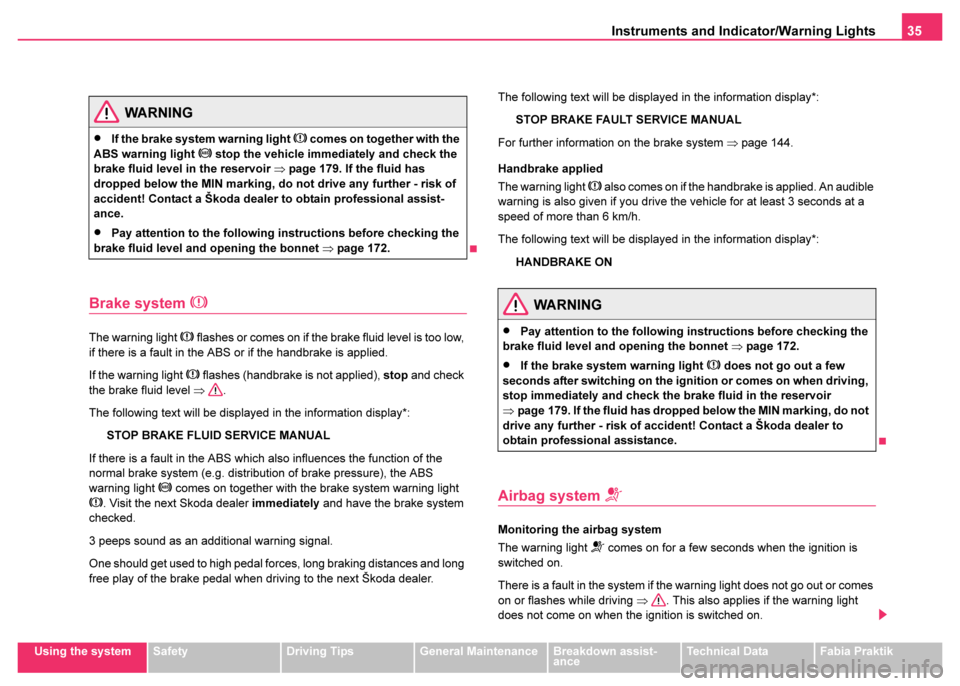
Instruments and Indicator/Warning Lights35
Using the systemSafetyDriving TipsGeneral MaintenanceBreakdown assist-
anceTechnical DataFabia Praktik
Brake system
The warning light flashes or comes on if the brake fluid level is too low,
if there is a fault in the ABS or if the handbrake is applied.
If the warning light
flashes (handbrake is not applied), stop and check
the brake fluid level ⇒.
The following text will be displayed in the information display*:
STOP BRAKE FLUID SERVICE MANUAL
If there is a fault in the ABS which also influences the function of the
normal brake system (e.g. distribution of brake pressure), the ABS
warning light
comes on together with the brake system warning light . Visit the next Skoda dealer immediately and have the brake system
checked.
3 peeps sound as an additional warning signal.
One should get used to high pedal forces, long braking distances and long
free play of the brake pedal when driving to the next Škoda dealer. The following text will be displayed in the information display*:
STOP BRAKE FAULT SERVICE MANUAL
For further information on the brake system ⇒page 144.
Handbrake applied
The warning light
also comes on if the handbrake is applied. An audible
warning is also given if you drive the vehicle for at least 3 seconds at a
speed of more than 6 km/h.
The following text will be displayed in the information display*:
HANDBRAKE ON
Airbag system
Monitoring the airbag system
The warning light
comes on for a few seconds when the ignition is
switched on.
There is a fault in the system if the warning light does not go out or comes
on or flashes while driving ⇒. This also applies if the warning light
does not come on when the ignition is switched on.
WARNING
•If the brake system warning light comes on together with the
ABS warning light stop the vehicle immediately and check the
brake fluid level in the reservoir ⇒page 179. If the fluid has
dropped below the MIN marking, do not drive any further - risk of
accident! Contact a Škoda dealer to obtain professional assist-
ance.
•Pay attention to the following instructions before checking the
brake fluid level and opening the bonnet ⇒page 172.
WARNING
•Pay attention to the following instructions before checking the
brake fluid level and opening the bonnet ⇒page 172.
•If the brake system warning light does not go out a few
seconds after switching on the ignition or comes on when driving,
stop immediately and check the brake fluid in the reservoir
⇒ page 179. If the fluid has dropped below the MIN marking, do not
drive any further - risk of accident! Contact a Škoda dealer to
obtain professional assistance.
Page 38 of 233
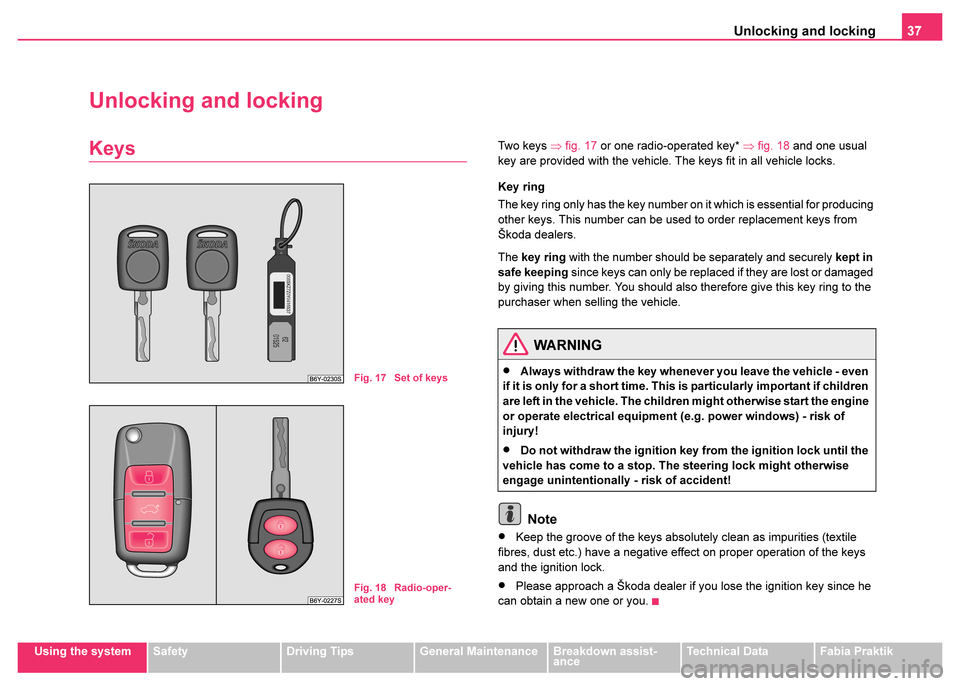
Unlocking and locking37
Using the systemSafetyDriving TipsGeneral MaintenanceBreakdown assist-
anceTechnical DataFabia Praktik
Unlocking and locking
KeysTw o k ey s ⇒fig. 17 or one radio-operated key* ⇒fig. 18 and one usual
key are provided with the vehicle. The keys fit in all vehicle locks.
Key ring
The key ring only has the key number on it which is essential for producing
other keys. This number can be used to order replacement keys from
Škoda dealers.
The key ring with the number should be separately and securely kept in
safe keeping since keys can only be replaced if they are lost or damaged
by giving this number. You should also therefore give this key ring to the
purchaser when selling the vehicle.
Note
•Keep the groove of the keys absolutely clean as impurities (textile
fibres, dust etc.) have a negative effect on proper operation of the keys
and the ignition lock.
•Please approach a Škoda dealer if you lose the ignition key since he
can obtain a new one or you.
Fig. 17 Set of keys
Fig. 18 Radio-oper-
ated key
WARNING
•Always withdraw the key whenever you leave the vehicle - even
if it is only for a short time. This is particularly important if children
are left in the vehicle. The children might otherwise start the engine
or operate electrical equipment (e.g. power windows) - risk of
injury!
•Do not withdraw the ignition key from the ignition lock until the
vehicle has come to a stop. The steering lock might otherwise
engage unintentionally - risk of accident!
Page 40 of 233
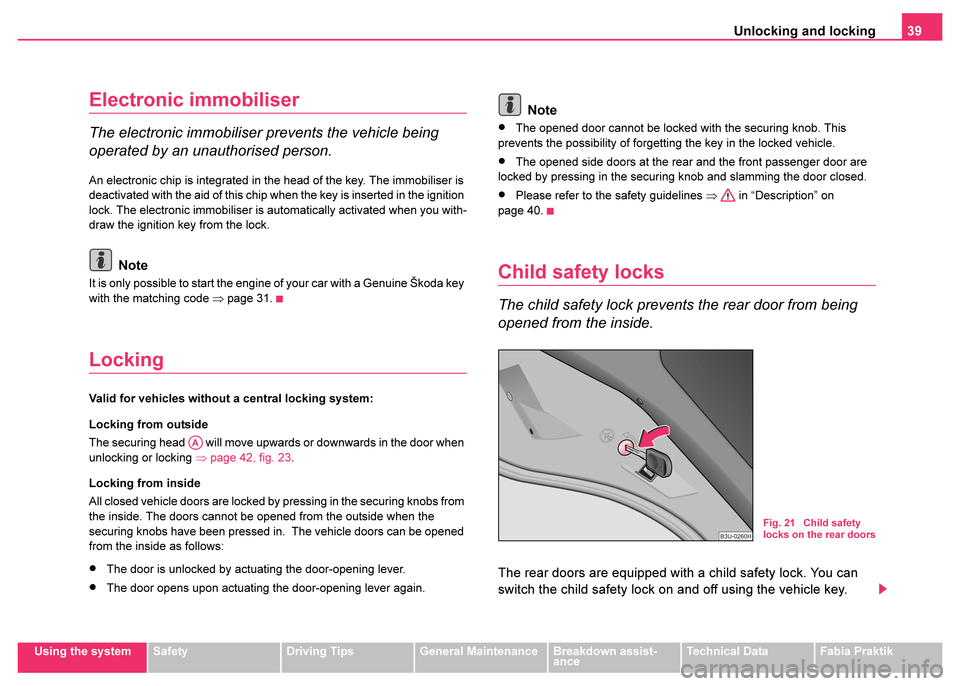
Unlocking and locking39
Using the systemSafetyDriving TipsGeneral MaintenanceBreakdown assist-
anceTechnical DataFabia Praktik
Electronic immobiliser
The electronic immobiliser prevents the vehicle being
operated by an unauthorised person.
An electronic chip is integrated in the head of the key. The immobiliser is
deactivated with the aid of this chip when the key is inserted in the ignition
lock. The electronic immobiliser is automatically activated when you with-
draw the ignition key from the lock.
Note
It is only possible to start the engine of your car with a Genuine Škoda key
with the matching code ⇒page 31.
Locking
Valid for vehicles without a central locking system:
Locking from outside
The securing head will move upwards or downwards in the door when
unlocking or locking ⇒ page 42, fig. 23.
Locking from inside
All closed vehicle doors are locked by pressing in the securing knobs from
the inside. The doors cannot be opened from the outside when the
securing knobs have been pressed in. The vehicle doors can be opened
from the inside as follows:
•The door is unlocked by actuating the door-opening lever.
•The door opens upon actuating the door-opening lever again.
Note
•The opened door cannot be locked with the securing knob. This
prevents the possibility of forgetting the key in the locked vehicle.
•The opened side doors at the rear and the front passenger door are
locked by pressing in the securing knob and slamming the door closed.
•Please refer to the safety guidelines ⇒ in “Description” on
page 40.
Child safety locks
The child safety lock prevents the rear door from being
opened from the inside.
The rear doors are equipped with a child safety lock. You can
switch the child safety lock on and off using the vehicle key.
AA
Fig. 21 Child safety
locks on the rear doors
Page 42 of 233
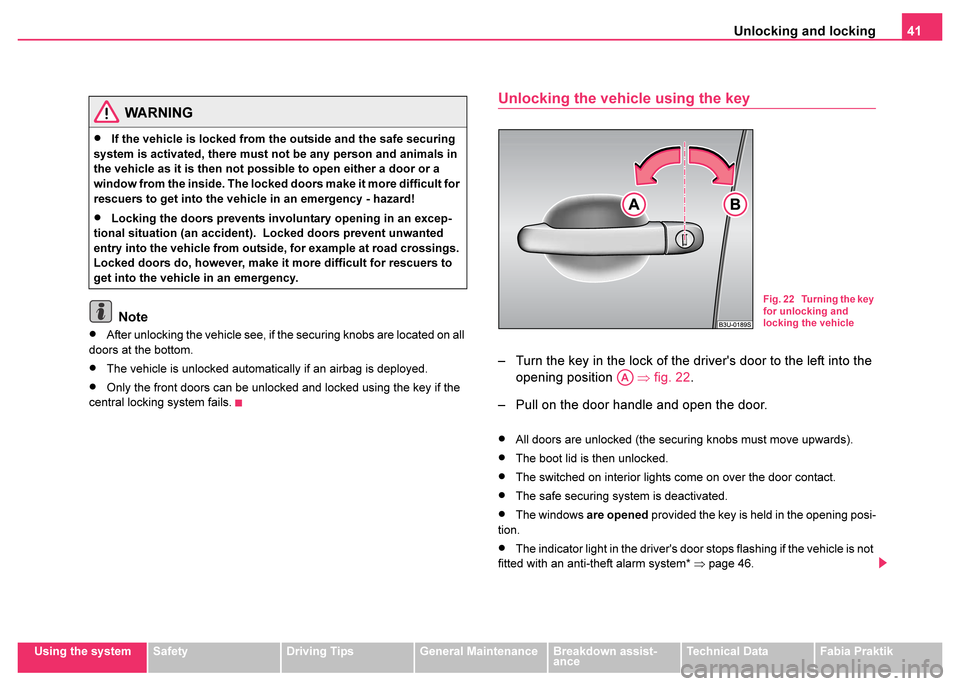
Unlocking and locking41
Using the systemSafetyDriving TipsGeneral MaintenanceBreakdown assist-
anceTechnical DataFabia Praktik
Note
•After unlocking the vehicle see, if the securing knobs are located on all
doors at the bottom.
•The vehicle is unlocked automatically if an airbag is deployed.
•Only the front doors can be unlocked and locked using the key if the
central locking system fails.
Unlocking the vehicle using the key
– Turn the key in the lock of the driver's door to the left into the opening position ⇒fig. 22 .
– Pull on the door handle and open the door.
•All doors are unlocked (the securing knobs must move upwards).
•The boot lid is then unlocked.
•The switched on interior lights come on over the door contact.
•The safe securing system is deactivated.
•The windows are opened provided the key is held in the opening posi-
tion.
•The indicator light in the driver's door stops flashing if the vehicle is not
fitted with an anti-theft alarm system* ⇒page 46.
WARNING
•If the vehicle is locked from the outside and the safe securing
system is activated, there must not be any person and animals in
the vehicle as it is then not possible to open either a door or a
window from the inside. The locked doors make it more difficult for
rescuers to get into the vehicle in an emergency - hazard!
•Locking the doors prevents involuntary opening in an excep-
tional situation (an accident). Locked doors prevent unwanted
entry into the vehicle from outside, for example at road crossings.
Locked doors do, however, make it more difficult for rescuers to
get into the vehicle in an emergency.
Fig. 22 Turning the key
for unlocking and
locking the vehicle
AA
Page 44 of 233
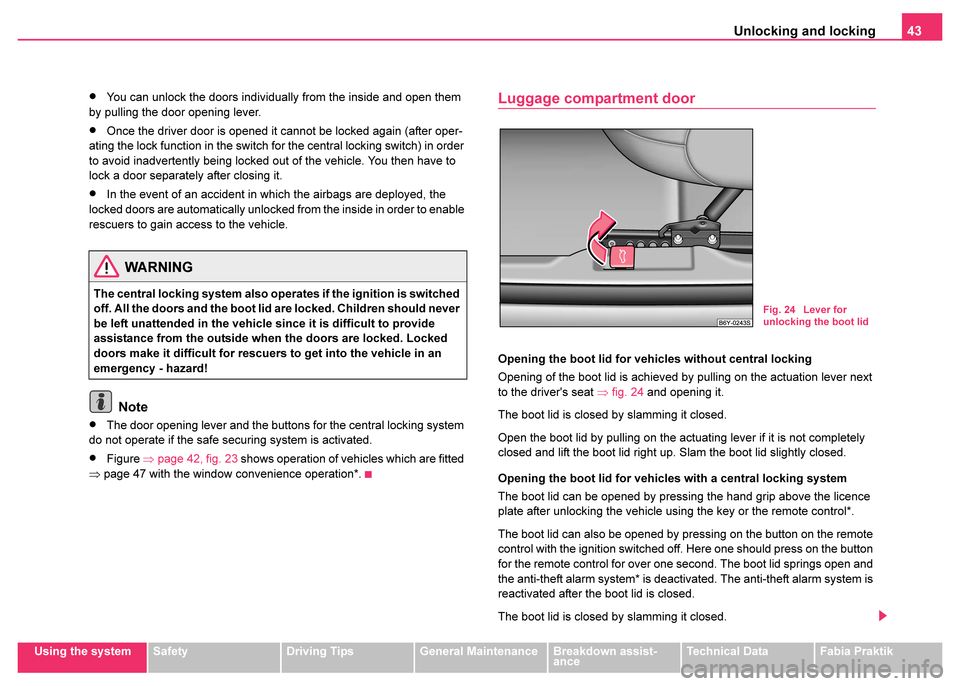
Unlocking and locking43
Using the systemSafetyDriving TipsGeneral MaintenanceBreakdown assist-
anceTechnical DataFabia Praktik
•You can unlock the doors individually from the inside and open them
by pulling the door opening lever.
•Once the driver door is opened it cannot be locked again (after oper-
ating the lock function in the switch for the central locking switch) in order
to avoid inadvertently being locked out of the vehicle. You then have to
lock a door separately after closing it.
•In the event of an accident in which the airbags are deployed, the
locked doors are automatically unlocked from the inside in order to enable
rescuers to gain access to the vehicle.
Note
•The door opening lever and the buttons for the central locking system
do not operate if the safe securing system is activated.
•Figure ⇒page 42, fig. 23 shows operation of vehicles which are fitted
⇒ page 47 with the window convenience operation*.
Luggage compartment door
Opening the boot lid for vehicles without central locking
Opening of the boot lid is achieved by pulling on the actuation lever next
to the driver's seat ⇒fig. 24 and opening it.
The boot lid is closed by slamming it closed.
Open the boot lid by pulling on the actuating lever if it is not completely
closed and lift the boot lid right up. Slam the boot lid slightly closed.
Opening the boot lid for vehicles with a central locking system
The boot lid can be opened by pressing the hand grip above the licence
plate after unlocking the vehicle using the key or the remote control*.
The boot lid can also be opened by pressing on the button on the remote
control with the ignition switched off. Here one should press on the button
for the remote control for over one second. The boot lid springs open and
the anti-theft alarm system* is deactivated. The anti-theft alarm system is
reactivated after the boot lid is closed.
The boot lid is closed by slamming it closed.
WARNING
The central locking system also operates if the ignition is switched
off. All the doors and the boot lid are locked. Children should never
be left unattended in the vehicle since it is difficult to provide
assistance from the outside when the doors are locked. Locked
doors make it difficult for rescuers to get into the vehicle in an
emergency - hazard!
Fig. 24 Lever for
unlocking the boot lid